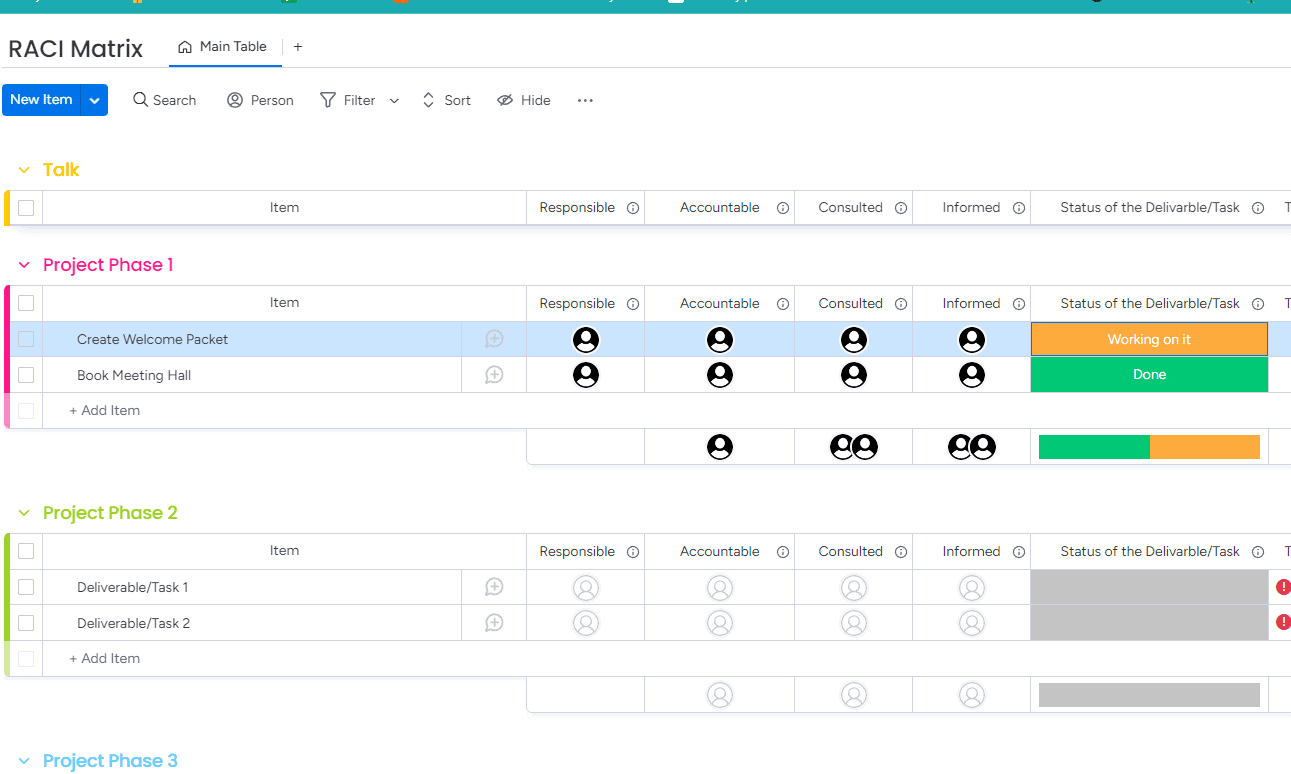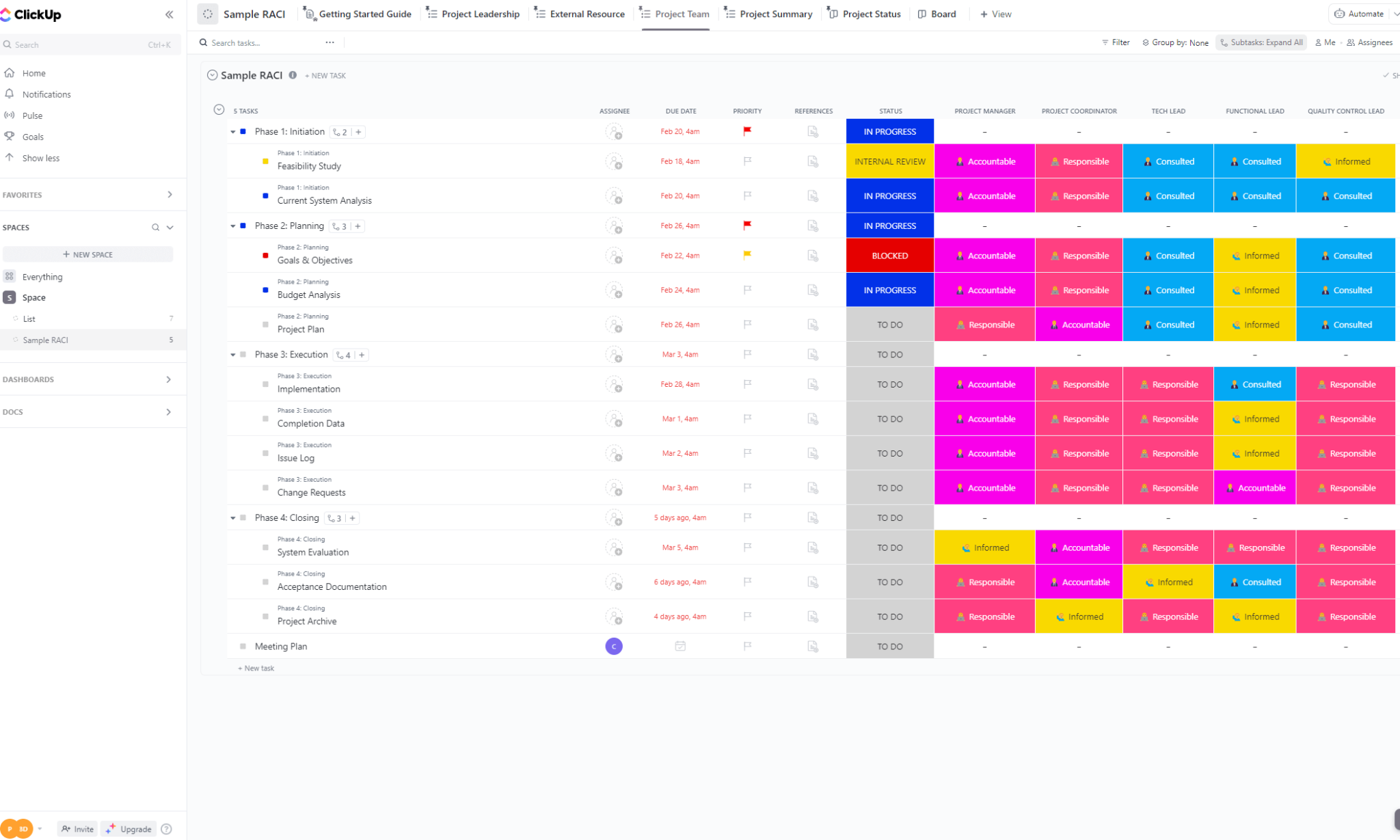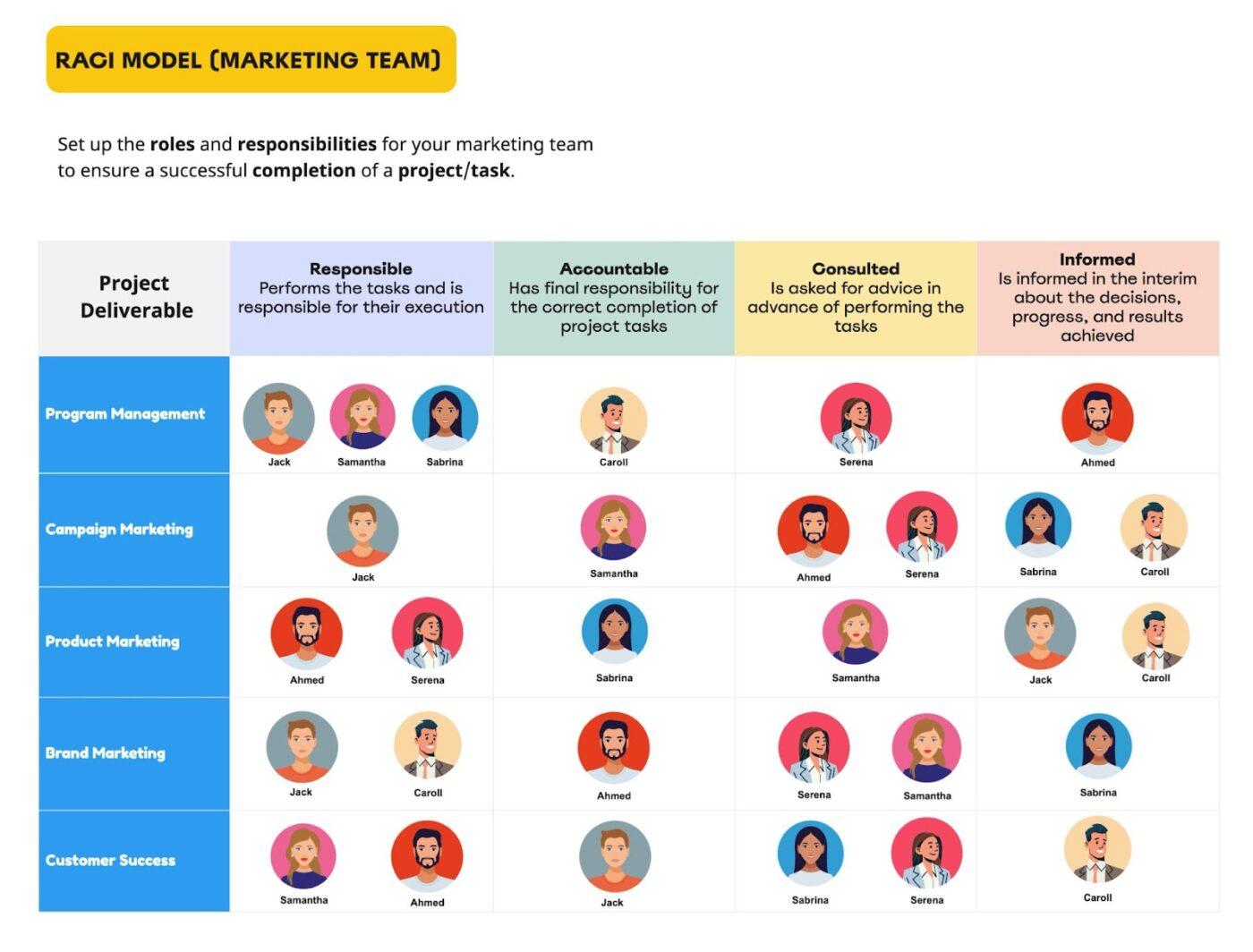[Deep Dive] Lost in Collaboration: Use a RACI Matrix to bring accountability to your team
If your latest digital project is descending into chaos, you’re not alone. Trying to coordinate multiple stakeholders while managing complex technical tasks is an immense challenge. But there is a solution - the RACI model.
As an experienced digital project manager, I’ve seen my fair share of disorganised initiatives crumble under misaligned priorities and poor communication. Implementing a RACI matrix was a total game-changer for restoring order and accountability. If you aren’t already using one, then you need to give it a try.
In this guide designed specifically for digital PMs, I’ll explain how the RACI model works and share tactical tips for creating an effective RACI matrix tailored to your specific situation. With a clear roadmap of responsibilities in place, you’ll be equipped to reign in the madness.
Here’s what we’ll cover:
- Core benefits of RACI for digital PMs
- Step-by-step instructions for building a RACI matrix
- Real-world examples of RACI roles for tasks
- Creative ways to adapt the RACI model digitally
- Common pitfalls and how to avoid them
A well-crafted RACI matrix distributes digital duties clearly, resolves approval bottlenecks, and tightly aligns business and technical stakeholders. By clearly mapping responsibilities for every project task, you’ll minimise redundant work, eliminate ambiguity, and save time on comms.
Let’s dive in.
Core benefits of RACI for digital PMs
As a digital PM, you juggle an intricate web of complex technical tasks, cross-functional teams, and competing business priorities (even more so if you work in an agency!). Without clear ownership for deliverables, projects become disorganised and messy.
Implementing a RACI matrix has monumental benefits for restoring order:
- Streamlined Decision-Making: A RACI matrix clearly defines approval channels so you can make quicker decisions without bottlenecks. No more waiting days for signoff while tasks stall.
- Technical Alignment: Distinct roles for technical and business stakeholders foster better collaboration. With assigned digital responsibilities, misalignment issues are proactively avoided.
- Accelerated Delivery: With an at-a-glance view into workload distribution, you can rapidly rebalance resources to avoid duplication and hit timelines.
- Enhanced Visibility: You’ll have transparency into the status of digital components and can course correct in real-time if anything slips.
- Improved Morale: When responsibilities are unclear, teams get frustrated over lack of progress. RACI empowers people and boosts morale by providing clarity.
Cross-functional collaboration is inevitable, but it can often descend into ambiguity without structure. A RACI matrix translates the ambiguity around roles and responsibilities into a clear list, mapping out who owns what.

Example of a simple RACI chart (also known as a responsibility assignment matrix).
Now let’s explore how to build a RACI matrix tailored to your unique ecosystem…
Step-by-step instructions for building a RACI matrix
The most crucial step is comprehensively mapping all the key tasks and stakeholders involved in your digital initiative.
Start by outlining every major deliverable and sub-task needed to successfully launch, operate, and iterate on your digital product. Get very detailed here - break down steps like configuring servers, integrating APIs, performing security audits etc.
Next, catalogue all the parties associated with these tasks - development teams, designers, business analysts, department heads that will use the product, and any external vendors or partners.
With your tasks and stakeholders listed out, it’s time to assign RACI roles:
🇷 - Responsible: The hands-on doers executing the work
🇦 - Accountable: The final decision maker who takes ownership
🇨 - Consulted: Subject matter experts who provide input
🇮 - Informed: Those notified of status and outcomes

RACI definitions explained.
Aim to designate at least one Responsible and one Accountable party for every task. Identify key experts to Consult and those to keep Informed.
Limit Accountable roles for clarity. Have technical tasks owned by dev/IT resources and business priorities owned by business analysts/department heads.
Doing this digital mapping upfront will pay dividends by efficiently distributing duties between teams. This structure will give you an at-a-glance view into your project that will help you better coordinate resources.
Examples on Project Management platforms

Example RACI on Monday.com

Example RACI on ClickUp

Example RACI on Miro
My top tips:
👉 Only allow 1 person to be Responsible or Accountable for each task. If you put 2, they will both assume the other one is doing the task!
👉 Be really specific about who is doing each role. If you just put ‘client’ should be responsible for sign-off, which person client-side? What if one of them is on holiday? Name specific individuals as Responsible (e.g. Client project owner) and Accountable (e.g Client project sponsor) for sign-off.
Now let's look at some real-world examples...
Real-world examples of RACI roles for tasks
To clearly illustrate how RACI translates to tactical responsibilities, let’s have a look at a few examples:
Task: Build custom digital product features
R: Software engineering team
A: Product manager
C: Key internal stakeholders requesting features
I: External vendors supporting product
For core software development efforts, engineers should be Responsible for hands-on build work. Feature priorities come from the Product manager who is ultimately Accountable for what gets built. Key internal stakeholders are Consulted to ensure alignment. External vendors are Informed of any changes that may impact their integration.
Task: Review site architecture and infrastructure
R: IT architect
A: IT manager
C: Info security team, Engineering manager
I: Digital product manager
The IT architect should be Responsible for assessing and optimising the infrastructure powering your digital platforms. The IT manager remains Accountable for the overall quality and security of IT systems. Info security and engineering leaders need to be Consulted given cyber and software implications. The digital PM is Informed so they understand how architectural choices impact roadmaps.
Task: Approve monthly web hosting invoices
R: Finance analyst
A: CFO
C: Digital marketing lead
I: Web development team
You want separation between financial Responsibilities and Accountability when it comes to paying vendor bills. Consult digital marketing leads using the tools on usage needs. And keep your web team Informed of costs so they consider efficiency.
Task: Develop website wireframes
R: UX designer
A: Web project manager
C: Client representative
I: Marketing manager
The UX designer is Responsible for creating the wireframes, which are low-fidelity representations of the website’s layout and functionality. The web project manager is Accountable for ensuring that the wireframes are completed on time and within budget. The client representative is Consulted to provide feedback on the wireframes. The marketing manager is Informed of the progress on the wireframes so that they can plan their marketing campaigns accordingly.
Task: Write website content
R: Content writer
A: Marketing manager
C: Subject matter experts (SMEs)
I: Design team
The content writer is Responsible for writing the website content, which should be clear, concise, and informative. The marketing manager is Accountable for ensuring that the website content aligns with the company’s brand and messaging. SMEs are Consulted to provide input on the accuracy of the website content. The design team is Informed of the content so that they can design the website accordingly.
Task: Test website functionality
R: QA tester
A: Web project manager
C: Client representative
I: Development team
The QA tester is Responsible for testing the website functionality to ensure that it is working as expected. The web project manager is Accountable for ensuring that the website is bug-free and meets all of the client’s requirements. The client representative is Consulted to provide feedback on the website’s functionality. The development team is Informed of any bugs or issues that are found during testing so that they can be fixed.
Task: Conduct User Acceptance Testing (UAT) for New Website Features
R: Quality Assurance Team
A: Project Manager
C: Customer Support Team
I: Front-end Development Team
When it comes to testing new website features, the Quality Assurance Team is Responsible for conducting thorough UAT. The Project Manager is Accountable for the successful completion of the testing phase. The Customer Support Team is Consulted to gather feedback on potential user issues, ensuring a customer-centric approach. The Front-end Development Team is Informed about any bugs or issues identified during testing.
Task: Deploy website to production
R: DevOps engineer
A: Web project manager
C: Client representative
I: Design team, Content team, Marketing manager
The DevOps engineer is Responsible for deploying the website to production. The web project manager is Accountable for ensuring that the website is deployed smoothly and without any downtime. The client representative is Consulted to ensure that the website is deployed to production on the agreed-upon date. The design team, content team, and marketing manager are Informed of the deployment so that they can make any necessary updates to their respective areas.
Task: Monitor website performance
R: Web analytics analyst
A: Marketing manager
C: Client representative
I: Sales team, Customer support team
The web analytics analyst is Responsible for monitoring website performance and providing insights into how the website is being used. The marketing manager is Accountable for using the data to improve the website’s performance and achieve marketing goals. The client representative is Consulted on the results of the monitoring to ensure that they are meeting their website objectives. The sales team and customer support team are Informed of any issues that are found so that they can take corrective action.
Task: Define and Implement SEO Strategy for the Website
R: SEO Specialist
A: Digital Marketing Manager
C: Content Team
I: Web Development Lead
In the realm of website development, the SEO Specialist takes on the Responsibility of defining and implementing the SEO strategy. The Digital Marketing Manager is Accountable for the overall success of the website’s SEO efforts. The Content Team is Consulted to align content creation with SEO goals. The Web Development Lead is Informed about any technical considerations that may impact SEO implementation.
Hopefully these real-world examples illustrate how RACI forces clarity into who owns what in digital workflows. Next let’s get creative in adapting RACI digitally…
Creative ways to adapt the RACI model
The RACI model is incredibly versatile and can adapt to fit most of the tools or systems you already use.
Here are some creative ways to implement a RACI digitally:
Visual Mapping
Leverage digital mind mapping tools to create an interactive RACI chart networked to show connections between tasks and stakeholders for an intuitive big-picture view.

RACI Stakeholder Map Example in Miro

RACI Roles in ClickUp’s Whiteboard View
Digital Dashboards
Build RACI into your real-time dashboards so tasks automatically map to owners. Embed RACI directly into your reports for clarity into responsibilities.
Collaborative Software
Maintain your RACI digitally in collaborative documents so it remains a “living” resource that evolves as projects progress. Enable commenting so it becomes a community tool.
Email Signatures
Have team members list their RACI roles in email signatures and messaging apps so colleagues instantly know who owns what.
Project Management Integration
Work with your PMs to overlay RACI data into platforms like Asana, Jira, Trello etc. Attach RACI matrices to specific tasks so tech and business teams access responsibilities in tools they already use.
The way you will use the RACI framework will be unique to every organisation so embrace digital channels to make responsibilities visible across your tools and systems.
Next let’s explore pitfalls to avoid…
Common RACI pitfalls and how to avoid them
While a RACI framework is invaluable for keeping order, there are a few key pitfalls to sidestep:
- Micromanaging resources: Avoid over-burdening individuals and confuse responsibilities with prescribing set-in-stone workflows.
- Outdated distributions: Revisit your RACI regularly as projects evolve to keep roles relevant.
- Assuming consensus: Get signoff from all parties during initial mapping and updates.
- Prioritising tools over conversations: Don’t let your RACI become a detached spreadsheet. Facilitate active collaboration around responsibilities.
With some diligence, you can leverage RACI thoughtfully to empower your team and help executives have clarity into progress. Keep responsibilities loosely mapped at a high-level rather than strictly prescribed lower down.
RACI as a framework is incredibly impactful, but don’t become overzealous with granular documentation. Integrate RACI guidance holistically across your platforms for assumed clarity on decisions and alignment.
Conclusion
Having a scalable system for managing cross-functional coordination is non-negotiable in my opinion. An intelligently crafted RACI matrix serves as the backbone for organising unwieldy technical initiatives and business priorities alike into smoothly synchronised systems. So next time you feel a project descending into ambiguity, pull out your RACI. With clear responsibilities distributed across all stakeholders, you’ll be empowered to translate complexity into coordinated effort and accelerated results.
There you have it - a comprehensive guide to transforming chaotic projects with the incredible power of the RACI model. Let me know if any questions pop up on your RACI journey.

Further reading:
- The limits of RACI—and a better way to make decisions
- What is a RACI Chart? Learn From an Experienced User
- How to use RACI charts for improved project ownership and team collaboration
- RACI model: A map for team structure (with template)
- What Is a RACI Chart? How to Use RACI to Assign Project Roles
- Cloudwards Complete RACI Chart Guide 2023: Definition, Examples and Templates
- 9 RACI Chart Examples for Project Management
